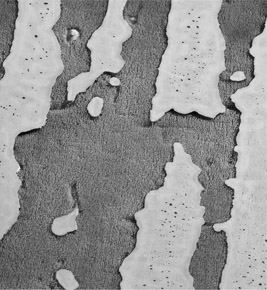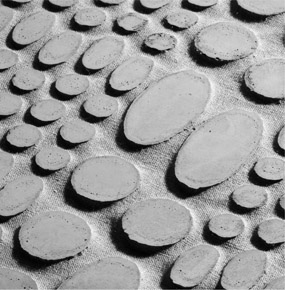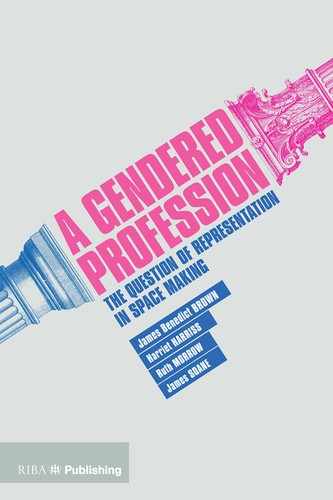This chapter summarises some of the learning from a material practice that sits in a sisterly manner next to architecture. Drawing on feminist writing and the experiences of women in professional life more generally, the chapter will examine how mainstream understanding of time and technology limit the engagement of those people in society who do not fit given norms. The chapter argues that when we examine such concepts in more detail and expand them to reflect diverse experiences those very same concepts offer new potentials and innovative openings for the progression of disciplines such as architecture.
Inclusive Feminism as Context
This chapter is written from an inclusive feminist perspective. There is no clear definition of inclusive feminism that I am aware of, but it goes beyond acknowledging intersectionality, i.e. that women have multiple facets to their identity (race, gender, ethnicity, ability, etc.) that cannot be viewed distinctly and which, if excluded from the focus of feminism, can create an intensified form of discrimination at the intersection (e.g. between race and gender; ability and sexuality). Inclusive feminism also goes beyond attempts to define commonality across ‘womenhood’ – since these set up boundary conditions which in turn become a source of further discrimination, especially for those who identify as bi, trans, fluid, agender etc.1
My personal understanding of inclusive feminism is influenced by early involvement in the inclusive design movement which grew out of the disability movement, and which acknowledged that by addressing the needs of people in critical contexts (i.e. those disabled by society) we could also design/manage processes and products for all people.2 And that’s how I view inclusive feminism: as a critical movement able to examine underlying behaviours and cultures that exclude and undervalue women but which inevitably allows us to accept difference and the rolling need to negotiate between, empower and liberate all people – regardless of their given, adopted or assumed gender identities. In other words, women may be the subject of feminism, but the long-term objective of inclusive feminism is equality across all gender/sex identities.
Material, Theoretical, and Lived

Velvet infused concrete

Stitched linen infused concrete
The sister practice at the heart of this chapter is a collaborative material practice developed by a textile designer and an architect in utopian pursuit of making hard things soft.3 Over its 10-year lifespan it evolved patented technology to conjoin concrete and textiles, resulting in highly tactile surfaces, eventually commercialised through a start-up company, Tactility Factory.4 As one of the two female co-founders, I have turned throughout the company’s development to feminist writing in order to locate and frame the work and, more crucially, to make sense of some of the day-today challenges we faced. Here I will focus specifically on how we had to rethink our position towards mainstream conceptions of time and technology. However, we have equally had to confront long held practices and views on networks and language.5 Time and technology are integral to all material practices, including architecture. Looking first at the experiences within Tactility Factory of each of these social constructs, I then refer to wider experiences of women in relation to time and technology.
Taking Time
Time has played a critical role in Tactility Factory. Like any creative material practice (such as architecture) it takes time to evolve and become knowledgeable and skilful around materials. Initially we believed that the work simply involved bringing two materials together – concrete and textiles – imagining that once we had mastered their marriage we would move on to other materials. In fact, fusing materials in a manner that has never been done before requires a new set of techniques and a new approach. It takes time before a manual sensibility of materials evolves that is not only sufficiently skilful but able to suffuse the material outcomes with quality. In addition to the time required to develop and master materials, Trish Belford, the other co-founder, and I have always worked part-time in Tactility Factory, essentially because we are both the sole income providers for our respective households and have to maintain full-time employment out of financial necessity. Being part-time has inevitably impacted on the time it has taken to develop the processes and the company. In the world of start-ups the general perception is that slow growth indicates low and potentially no-market traction. Moreover working part-time is occasionally perceived as ‘lacking commitment’ and, as Bridgit Fowler and Fiona Wilson suggest in relation to architectural practice, can be easily stigmatised and marginalised.6 However, we would argue – forcibly – that our prolonged, if part-time, engagement in the development of Tactility Factory is in fact a sign of dogged and sustained commitment.

Infused concrete surfaces in the making
Whose Work?
Time plays a significant role in gender studies, particularly in the interrelationship between women, work and time. Of those women in employment in the UK, 43% work part-time, in comparison to 13% of men.7 Women work part-time chiefly because of the caring roles they take on. Recent research indicates that diversity in work-family arrangements has increased post-2008 recession and that the working hours of fathers are becoming more sensitive to family structures, though the stigma around being a male carer still seems to inhibit men from sharing the role fully (this is echoed in the relatively poor uptake on paid paternity leave in the UK).8
Those who care for others are also more likely to be responsible for domestic duties. Despite time-saving household devices, such as washing machines and dishwashers, which historically led to an increase in women’s involvement in the labour market, the phenomenon of the ‘second shift’ or the ‘household shift’ arose.9 On returning home, working women in heterosexual relationships carry out the majority of the housework. It is argued that this phenomenon still continues to curtail women’s engagement with high-demand careers.10 Women’s time is also impacted on by the planning of cities into distinctive zones (shopping, work, residential), creating multi-nodal journeys between home, school, work, and health services.11 Such protracted journeys are particularly draining for those with caring roles. Valerie Bryson defines this strain on women’s lives as ‘time poverty’ and argues that the unequal distribution of ‘disposable time’ among the genders affects women negatively in two ways.12 Firstly, that having disposable time for the individual is a ‘primary good in itself’, and secondly, that it is a resource that citizens need if they are to further themselves, promote their concerns, and contribute to local politics and decision making. As such, time poverty acts as a constraint on the active and valued citizenship of women but, perhaps more critically, she argues that women fall outside normative ‘time cultures’, and that their temporal rhythms do not sync with the ‘commodified clock time of capitalist culture’.13 Hence women’s time tends to be undervalued and fails to connect to mainstream power structures.
Kathi Weeks brings the discussion to another level: in The Problem with Work: Feminism, Marxism, Antiwork Politics and Postwork Imaginaries. Here, she critiques the ‘sometimes pro-work suppositions and commitments’ of feminism, and fundamentally questions whether work is in fact an inevitable activity at a time when, increasingly, ‘there is not enough work to go around’. She argues for a reduction in work hours without a reduction in pay, as much to enhance people’s productive/creative practices and experiences as to provoke a reconceptualisation of the role and value of work in society. Hers is a deliberate provocation designed ‘to challenge the dominant legitimating discourse of work’.14 Thus Kathi Weeks’ petition for reduced working hours is also aimed at engaging us in a deeper questioning, politicising, and, thus, reforming of the work environment.
Work-Time-Play-Mistresses
Perhaps the answer is to understand practice as an essential mix of work and play. Certainly work/time/play relationships have created significant moments of reflection for us in Tactility Factory. Maintaining a playful attitude is critical when developing ideas and ‘things’ beyond normal realms. Like most creative practitioners we take play seriously. Mess and mistakes, dreams and wasted efforts are part of the cycle, culminating in close, careful observations of the material outcomes. By accepting that the interrelationship of work and play (non-work) has always been critical and contentious for not only creative people, but, especially women, it helps us to understand the necessity to manage and indeed celebrate the tensions, resisting two-dimensional readings of how we handle our time. As a recent Wall Street Journal article suggests, the key is to ‘rethink the clock’ by designing jobs that ‘enable people to contribute at varying levels of time commitment whilst still meeting our overall goals for the company’.15
Parlour, the Australian project on women, equity and architecture, published guides in 2015 aimed at improving the architecture profession for women. Of the 11 guides to ‘Equitable Practice’, three dealt directly with the work/time relationship, i.e. ‘Long hours culture’, ‘Part-time work’ and ‘Flexibility’, demonstrating not only the significance of time in work cultures but also some pragmatic ways to bring about change in the architecture profession.16 There is clearly a marked urgency to reconceptualise our work/time relationships and to reconsider the balance of up time, down time, thinking time and play time.
Touching Technology
From my perspective, the collaborative material practice between myself and Trish that later become known as Tactility Factory evolved, in part, out of feminist and inclusive design critiques of the built environment that I had been previously been engaged in. These had recognised: the dominance of the visual and under-exploitation of the senses in the built environment; the increasing remoteness of the architect from the fabrication process; and the manufacture of built environment materials and components to meet only technical performance criteria (and not necessarily human performance). Across history, conceptual and stylistic shifts in architecture have paralleled technological advancements. Such technology-led architecture often has strong visual impact, but the experience of the resultant spaces can be alienating. We wanted instead to reinstate what the Irish engineer Peter Rice termed the ‘trace de la main’: the ability to sense from the material the hand of the designer/technologist/maker. Our ambition to capture and quite literally concretise touch in a material outcome has driven us to create our patented surfaces, bringing together the strength and robustness of concrete with the tactility of textiles. While we deploy prefabricated manufacturing processes and contemporary technologies to achieve the outcomes, we do so by interweaving an inclusive design approach with a balanced measure of digital and manual (analogue) techniques to ensure that the end experience tempts, entrances and sensorially seduces.

Textile designers call on a variety of hardcore chemical and mechanical processes often using abrasive and corrosive technologies to make artefacts that evoke intimate, emotive, physical, and intellectual responses. Technology is at the core of the textile designer’s processes but it is rarely present in the final experience of the product. The textile designer’s approach to technology as merely a means to an end gives us, as architects, much to reflect on. Understanding the concept of technology became an important secondary investigation of our work. Again, I turned to feminist writing to inform the practice; however, there is a real paucity of feminist writing on technology in respect to the built environment.17
The majority of writing centres on the body, reproduction, communication, and cyberspace.18 However, one author, Judy Wajcamn, offered an insight that has remained significant throughout our efforts.19 She proposed a three-layered definition of technology. The first layer is the technological ‘things’: the hardware and software, those components we usually associate with the term technology. The second layer is a form of knowledge that surrounds the ‘thing’ and arises during the making, repairing and maintaining of the thing. This, she says, is a tacit form of knowledge or know-how. The third layer of the definition is the interaction of people with know-how and the thing. For Wajcman all three layers are needed to make technology. For her, a ‘thing’ only becomes technology through human interaction and engagement. This socialisation of technology is emphasised by Deborah Johnson when she explains, ‘Technology is the combination of artefacts together with social practices, social relationships and arrangements, social institutions, and systems of knowledge.’20 She further argues that technological acts are historically gendered and that ‘domains of knowledge and skill mastered by men are called technical or technological while those mastered by women are considered crafts’. This is also reflected in the writings of Autumn Stanley, most notably in her book Mothers and Daughters of Invention: Notes for a Revised History of Technology, who argued that technologies only become lauded and understood as significant once they are appropriated by men.
In Tactility Factory, despite Trish’s renowned expertise in using a wide range of technologies to create innovative textiles, she initially never described herself as a technologist. In textiles the narrative about the technology of manufacture is wholly subservient to the sensory experience of the outcome. In Tactility Factory, however, we have learned to tell various stories depending on who is listening. To the commercial interior sector, we talk of the sensuous nature of the surfaces, the ability to create atmosphere and enriched experiences. To practising architects we speak about the cutting-edge technology, the patents and awards for innovation, emphasising that it is the textile technology that is the clever component of our surfaces – it’s a coded and loaded emphasis of course.
So does this Mean that Tactility Factory Generates Feminist Technology?
Linda Layne, Professor of Anthropology, asks: ‘Are feminist technologies simply or necessarily artefacts “designed by women, for women”? If a technology is feminist, how did it get that way? Is the feminism in the design process, in the thing itself, in the way it is marketed, or in the way it is used by women and/or by men?’ (Layne, Vostral et al. 2010).21 In the case of Tactility Factory, while the process was initiated and led by two women, both genders and gendered cultures have been part of its development. The process is certainly informed by feminism, but we would agree with Layne’s concluding statement that, ‘What matters is their [technologies’] effect and not their intended effect’. Certainly our wish has been to create a wider understanding of technology that includes us and allows us to practise with confidence, but in a manner that produces outcomes for all people.
Time Underwriting Material Quality
Through Tactility Factory, we have come to understand more fully the gendered dimensions of time and technology. It’s clear that our contemporary narratives around the technology of architecture are still incomplete and that an expanded definition of technology has the potential to draw in a wider societal representation. Like many practices, we manage our ‘part-time’ time tightly and look for ways to be effective in shorter and concentrated periods, but we also know the importance of ‘taking time’. This sense of taking time is surely central to any material practice in search of quality outcomes. The cyclical and incremental processes of trialling, developing, and gaining expertise require an investment of time, and where, as in Tactility Factory, the process also brings together unusual material combinations, a space has to be created where the relative technical cultures can work together to form a third culture: a new material practice. Both cultures have strong gender associations and differing stances to technology and it has required not only a transformation of established processes and tools, but of soft, personal and deeply held beliefs. Such cultural transformations also take time. In such contexts time becomes the underwriter of quality, and indeed in some instances has proved to be the guardian of our intellectual property.22 But taking time is an unusual and counterintuitive strategy in the ‘bring-it-to-market-as-fast-as-you-can’ business culture – it certainly generates live challenges when it comes to maintaining production quality under commercial deadlines.
Feminism Supporting Mainstream
Feminist writing helps identify the general issues that create friction for many in practice. It is less able, of course, to provide specific solutions since each context is different. But it helps at least to know that as individuals we are not the problem. Rather, it’s the given concepts – in this instance, technology and time – that have been historically framed to best fit what Rosemarie Garland-Thomson calls, the ‘normate’. That is, the very rare, if not almost fictional, white, cisgender, independent, educated, healthy male.23 Those who fall outside this norm find themselves at odds with and undermined by the conventional structures and operations of time and technology. The same can be said of innovative and critical material practices engaged in the development of social technologies, which can be almost characterised by being ‘out of sync’ or ‘ill-fitting’ within the normal conventions of practice. But looking at such sister practices through the lens of feminist theory helps us identify the need for more complex understandings of constructs (such as time and technology) building towards not just one-off material practices but a more inclusive mainstream architecture profession. This assumes, of course, that we as a profession want to mirror the diversity of society.
